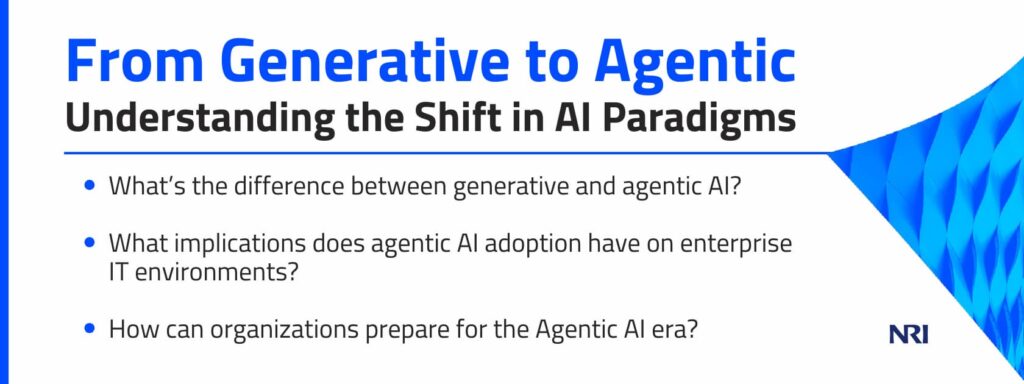A new era of human-machine collaboration awaits. Discover the key differences between Generative and Agentic AI and the implications of this shift.

Just a few years ago, generative artificial intelligence (GenAI) captured the world’s imagination with the launch of ChatGPT and similar models, allowing on-demand text, code, and image creation.
Today, the conversation is shifting to agentic AI—more innovative models that “suck up data, make decisions, and take action for us.”
During the just-concluded Nvidia 2025 Global Artificial Intelligence Conference (GTC), Nvidia’s CEO, Jensen Huang, proclaimed that we are on the cusp of an “agentic and reasoning AI” era where 10 billion autonomous digital workers (AI agents) will augment humans.
Is your enterprise ready for this paradigm shift? Here’s what to know:
Generative Vs. Agentic AI
Let’s start by asking how GenAI differs from Agentic AI.
Role
GenAI models create new content based on pre-trained data. They learn patterns and then generate text, code, images, or other outputs in response to user prompts. In contrast, Agentic AI models perform goal-driven tasks, make decisions, and act autonomously in dynamic environments. They can set or receive a goal and figure out how to accomplish it without ongoing prompts.
Interaction Style
With GenAI, humans are constantly in the loop. Users craft prompts or feedback and the AI adapts its output accordingly. Once configured and launched with an objective, Agentic AI can work independently. Without constant human guidance, it will explore, plan, and even correct itself. In effect, generative models are prompt-driven, while agentic models are self-driven.
Technology Stack
GenAI relies on large neural networks trained on static datasets of text, images, or code. Agentic AI layers on additional components—reinforcement learning, search algorithms, multi-agent frameworks, and even robotics control loops—allowing learning from interaction and feedback. For example, a generative model might use millions of articles to produce a policy draft. An agentic system could combine that model with real-time sensor data and control systems to implement and adjust policy actions in real time.
Implications for Enterprise IT Environments
The integration of agentic AI into enterprise IT environments necessitates a reevaluation of existing strategies and infrastructure.
Data and Compute Infrastructure
Agentic AI multiplies the demands on data pipelines and compute resources. High-performance computing—in centralized cloud and distributed edge devices—and low-latency networks will be needed to train and run agentic models. Leading AI vendors like NVIDIA are already building specialized “AI data platforms” and edge accelerators to meet these needs.
Integration and Interoperability
Unlike GenAI, which can function as a standalone application, agentic AI must be deeply integrated into existing systems. Enterprises will increasingly rely on orchestration layers to manage fleets of AI agents.
New standards are emerging to facilitate this integration. For example, recent “agentic protocol” frameworks like Anthropic’s Model Context Protocol (MCP) and Google’s Agent-to-Agent (A2A) API aim to let different AI agents communicate and coordinate.
In practice, IT teams may adopt platforms that treat AI agents like microservices—providing discovery, message-bus connectivity, and access controls—rather than standalone applications.
Oversight Mechanisms
Given their autonomy, agentic AI systems must be equipped with sandboxing environments for testing and auditing tools to monitor decision-making processes. Implementing oversight mechanisms will ensure AI actions align with organizational goals and compliance requirements.
Shifting Risk, Control, and Governance Models
Autonomous agents introduce new security vectors. For instance, if an AI agent can issue commands (even through an interface) to operational systems, it becomes a potential point of failure or attack. Further, just as businesses have grappled with “shadow IT” and “shadow AI,” without oversight, they could end up with unsanctioned AI agents.
To counter these risks, enterprises must extend their AI governance. The first step is visibility: IT needs tools to discover and inventory all AI agents in the environment. Similar to how security teams map devices on a network, governance tools should catalog AI services, APIs, and bots. Once agents are identified, they must be subjected to risk assessment, compliance assessment, and proper controls and guardrails.
Agents’ actions should be traceable and auditable. Enterprises should ensure that every agent’s workflows are logged and that they maintain an “explainable” decision trail. Pre-determined thresholds for bias must be set (much as we do for GenAI outputs). Continuous monitoring is also essential, and if an agent drifts off-course or starts ignoring context, humans must intervene. Lastly, access controls (which user/role can launch which agentic task) must be established.
Governance extends to the legal realm: if an autonomous agent causes an incident, who is accountable? Companies should update their policies to reflect this new liability.
Preparing the Organization for the Agentic AI Era
Transitioning to agentic AI is as much a people challenge as a technical one. IT leaders and decision-makers can take these proactive steps to build readiness:
- Upskill Your Team: Train staff on data literacy and how AI agents operate, evolving their roles from prompt engineers to behavior designers.
- Build Governance and Ethics Early: Update corporate AI policies to include agentic scenarios. Define who owns each type of agentic decision, set privacy and safety standards, and establish approval workflows for launching new agents. Involve security, compliance, and legal teams from the start. Also, create channels for continuous feedback: As agents are piloted, capture lessons about bias and security loopholes and make improvements.
- Do a Phased Roll-Out: Start small with contained use cases to prove value and refine as you see results.
In other words, treat the agentic AI like any other transformation initiative: plan early, invest in people, and align it with core business goals and IT strategy.
Lead the Shift with Confidence
The shift from generative to agentic AI is inevitable and full of opportunity for those who act. For forward-thinking IT decision-makers, now is the time to lead the shift and ensure that agentic AI serves your strategic goals rather than catching you off guard. And the good news is that the transition doesn’t have to be daunting with NRI by your side.
NRI is the trusted digital transformation partner that leading global organizations rely on to drive purposeful innovation and achieve lasting results. We can help you assess your Agentic AI readiness, develop an adoption roadmap, and follow up with precise execution of a custom solution tailored to your organization.
Ready to get started? Let’s chat!



